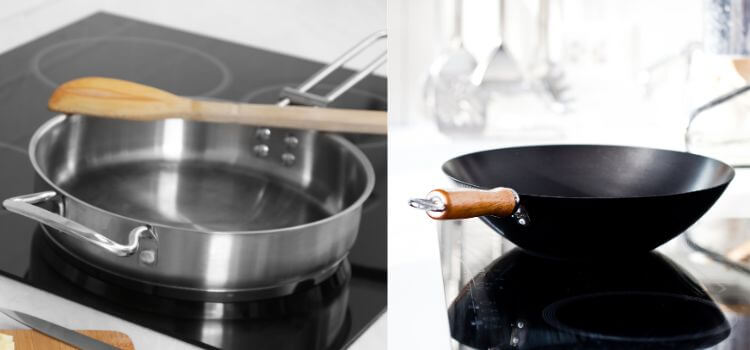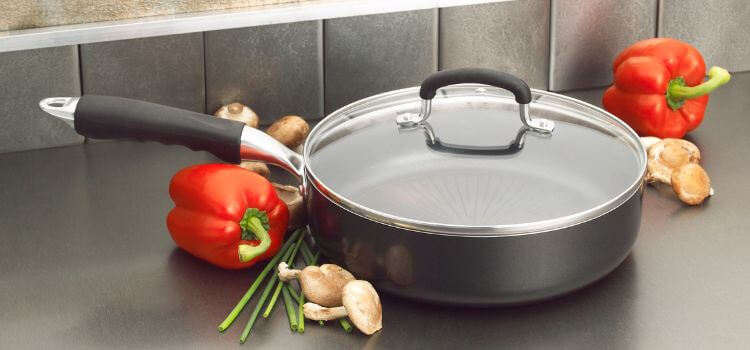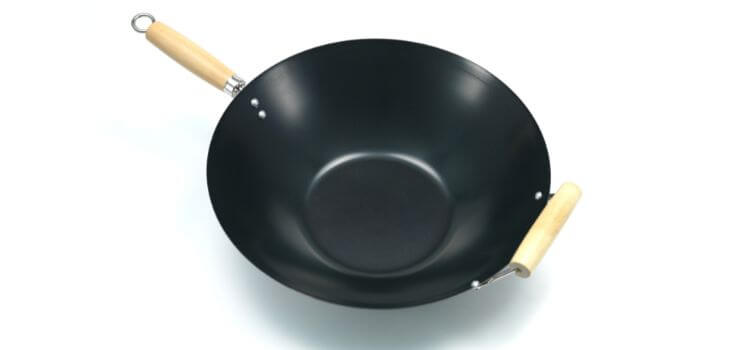As an Amazon Associate, I earn from qualifying purchases

In the realm of cooking, the selection of cookware plays a pivotal role in shaping the results of your culinary masterpieces. In the realm of stir-frying, two iconic pieces of cookware stand out: the sauté pan and the wok. Each has its own set of advantages and unique characteristics that can influence the flavors, textures, and overall experience of your dishes.
In this article, we’ll explore the differences between the sauté pan and the wok, helping you understand which one is best suited for various cooking techniques and ingredients. Whether you’re an experienced chef or a bold home cook, choosing the right tool can elevate your stir-frying adventures to new heights.
Understanding the Sauté Pan

A sauté pan is a versatile, shallow, and wide-based cooking vessel with straight or slightly sloping sides. It typically comes with a long handle and a lid. The bottom of the sauté pan can either be flat or rounded, depending on the manufacturer.
Commonly made from stainless steel, aluminum, copper, or cast iron, sauté pans come in various sizes to suit different cooking needs. The shallow depth of the pan allows for even heat distribution, making it perfect for searing, browning, and sautéing a variety of ingredients.
Cooking techniques suited for the sauté pan
Due to its vast and flat cooking surface, the sauté pan is ideal for techniques that require frequent stirring or flipping, such as sautéing, stir-frying, and searing. Its straight sides also make it suitable for shallow frying and braising.
Pros of using a sauté pan
- Even heat distribution: The wide base of the sauté pan ensures that heat is evenly distributed, preventing hot spots that can cause uneven cooking.
- Versatility: The sauté pan’s design makes it suitable for a variety of cooking techniques, giving you more options in the kitchen.
- Easy to maneuver: The long handle of the sauté pan allows for easy handling and movement while cooking.
Cons of using a sauté pan
- Limited capacity: The shallow design of the sauté pan limits its capacity, making it unsuitable for cooking large quantities of food.
- Not suitable for deep frying: The straight sides of the sauté pan make it challenging to hold a large volume of oil, making it less efficient for deep-frying.
Understanding the Wok

The wok is a traditional Asian cooking vessel typically made from carbon steel or cast iron. It has a rounded bottom and high, sloping sides that allow for efficient heat distribution and retention. Woks often come with two handles; one long handle for tossing and flipping and one short handle for holding.
Cooking techniques suited for the wok
The wok’s unique design makes it perfect for cooking techniques that require high heat and constant movement, such as stir-frying, deep-frying, steaming, and smoking. The sloping sides also make it easier to mix, toss, and flip ingredients.
Pros of using a wok
- High heat retention: The rounded bottom of the wok ensures that heat is evenly distributed and retained, making it perfect for quick and efficient cooking.
- Suitable for deep frying: The high sides of the wok make it ideal for holding a large volume of oil, making it perfect for deep-frying.
- Efficient use of oil: The unique shape of the wok allows you to stir fry food without using excessive amounts of oil, resulting in healthier meals.
Cons of using a wok
- Specialized design: The sloping sides and rounded bottom make the wok suitable for specific cooking techniques, limiting its versatility in the kitchen.
- Requires special care: Woks made from carbon steel or cast iron need to be seasoned properly and handled with care to prevent rusting.
Comparative Analysis: Saute Pan vs Wok
Heat Distribution and versatility
The sauté pan and the wok differ in heat distribution, with the sauté pan offering even heat across its wide, flat surface, suitable for browning and simmering, while the wok’s high, sloping sides concentrate heat at the bottom, ideal for quick stir-frying.
In terms of cooking versatility, the sauté pan accommodates a wide range of techniques, while the wok excels at high-heat cooking. The wok’s shape makes it perfect for tossing and flipping ingredients, whereas the sauté pan is more suitable for cooking with delicate ingredients that require uniform heat distribution.
Flavors and Textures
The choice between a sauté pan and a wok can significantly impact the flavors and textures of your dishes. The even heat distribution of the sauté pan may result in more balanced flavors, while the high heat retention of the wok can create deliciously caramelized and smoky notes. The sloping sides and unique shape of the wok also contribute to a distinct texture, with stir-fried ingredients retaining their crunch and freshness.
Practical Application and Recommendations
- For high-heat cooking techniques: Choose the wok for stir-frying, deep-frying, and smoking.
- For versatile cooking options, Go for a sauté pan that can also be used for shallow frying and braising.
- When cooking delicate ingredients, Opt for the sauté pan to ensure even heat distribution and prevent overcooking.
- For cooking large quantities: The sauté pan may be more suitable as the wok’s rounded bottom limits its capacity.
To be noted:
- Sauté Pan: Perfect for making sauces, searing meat, and cooking delicate seafood like shrimp.
- Wok: Ideal for stir-fry dishes like chow mein, fried rice, or vegetables with a spicy kick.
Conclusion
Both the sauté pan and the wok are essential additions to any kitchen, offering unique features and benefits for different cooking needs. By understanding their design, capabilities, and limitations, you can choose the right cookware for your specific recipes or techniques.
Consider having both in your kitchen to enjoy the best of both worlds – evenly cooked dishes with balanced flavors and those with a distinctive smoky, crunchy texture. Experiment with different dishes and techniques to fully explore the potential of these versatile cookware options.
Next time you find yourself in the kitchen, grab your reliable sauté pan or wok – better yet, use both! Unleash your creativity and culinary prowess. Enjoy your cooking experience!
As an Amazon Associate, I earn from qualifying purchases
Pingback: Fry Pan vs Saute Pan